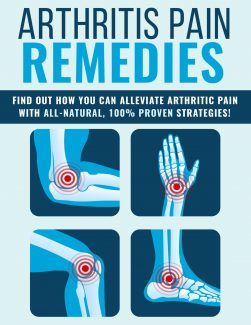 License Type: Private Label Rights
License Type: Private Label Rights  File Type: ZIP
File Type: ZIP
 SKU: 63175
SKU: 63175  Shipping: Online Download
Shipping: Online Download
Sample Content Preview
Introduction
Arthritis is a condition that can cause a plethora of symptoms, including deterioration of muscles and joints, a reduction of use in your main joints, and of course, severe pain.
Some cases of arthritis, like rheumatoid, can affect the immune system as well. There are constant and active studies on the conditions and your doctor knows the best treatment options for your specific situation.
Fortunately, on top of the modern medical treatment of arthritis, there are a few different things you can do daily to reduce and relieve the symptoms. Some studies have even shown that some of these all-natural treatments can even diminish symptoms of different types of arthritis!
In the following report, we will discuss 10 of the most widely used, all-natural forms of treatment for your arthritis symptoms. Most of the following treatments can even be done in the comfort of your own home, and can be combined with current medical treatments you may be receiving.
Hopefully, with implementation you can begin to live a healthier and more pain-free life with arthritis.
Let’s begin!
Important Note: It’s important that you seek the advice and approval from your health care provider prior to making any drastic changes to your diet, exercise, or supplement intake.
Tip #1: Regular Exercise
Exercise is vital to keeping those joints and muscles elongated, warmed up, and moving. Make sure to always discuss your weight and exercise routine with your physician before following any workout plan.
Keep in mind that exercise doesn’t have to mean 7 days at the gym pumping iron and running on treadmills. Regular movement, whether it’s walking around your home or participating in aerobic classes at your gym, does wonders for arthritic pain.
In the past, it was thought that exercise made arthritis pain worse, but this has been shown to, not only be untrue, but quite the opposite. Daily workouts help to build and maintain a strong and healthy cardiovascular and muscular system.
Beyond the strengthening and stretching you get from exercise, maintaining a healthy weight contributes in many other ways as well, such as reducing the strain on muscles and joints. If you are overweight, it is important that you set goals with your physician to reach your optimal healthy weight and that you set yourself up for long-term success, rather than short-term results.
Laura Robbins, Senior Vice President of Education and Academic Affairs at the Hospital for Special Surgery in New York, says that for every pound you lose, you reduce the pressure on your knees by four pounds.
In fact, Roy Altman, MD, Professor of Medicine at the University of California, has seen symptoms of arthritis completely disappear from patients that have lost ten to twenty pounds of excess weight.
Along with the symptoms of arthritis, you will be improving your overall mental and physical well-being, helping to control other ailments your body may face as you age. A strong heart and a strong mind can do wonders for pain management!
Tip #2: Hot & Cold Treatments
One of the main natural treatments for arthritis include hot and cold treatments. There are several different types of arthritis so make sure to ask your doctor which will be better for your specific symptoms.
Cold Therapy helps to reduce joint swelling and inflammation. This type of treatment is most often recommended to rheumatoid arthritis sufferers, but can help others as well.
You can alternate hot and cold treatments as needed but always monitor how your skin reacts and adjust or discontinue as needed.
Cold treatments should be limited to 20-minute sessions. Here are several cold treatments used:
Use a cloth covered bag of ice applied to the painful area.
Submerge the joint in an ice bath.
NOTE: Check with a physician before submerging, especially if it is a large area of the body.
Simple cold packs kept in fridge or freezer, applied when needed.
Heat therapy is often good for all other types of arthritis, as well as, in conjunction with cold treatments. The heat relaxes your muscles and helps blood flow to the affected area.
Heat treatments should be monitored and adjusted depending upon your body's reaction.
Here are several heat treatments widely used by arthritis sufferers:
Start your day with a hot bath or shower to get your blood flowing and joints relaxed.
A warm paraffin wax to affected joints. (This can often be done by a professional to monitor wax temperature.)
Apply a heating pad, heat pack, or other warm heat source to the affected joints.
Always make sure, when using heat therapy, to maintain a comfortable level of heat.
Hot tubs are also excellent ways to cover larger areas of the body, but always check with your physician first as they can be dangerous for those with certain health conditions.








